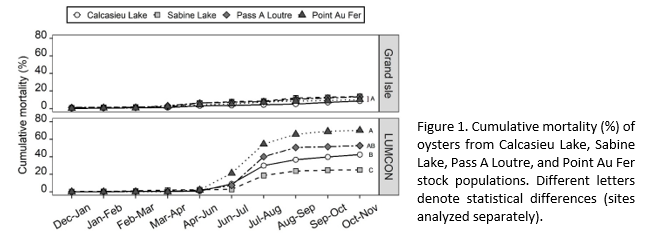ASSESSMENT OF UNIQUE LOUISIANA OYSTER Crassostrea virginica POPULATIONS FOR ADAPTATION TO LOW SALINITY
Eastern oysters (Crassostrea virginica) support a critical commercial industry and perform critical ecosystem services in coastal estuaries, but changing estuarine conditions call for increased farm management strategies. In particular, climate models and local management strategies predict increasing freshwater in productive oyster areas, creating a need for strategies to maintain production despite water quality changes. Although highly tolerant to a wide range of salinities and salinity variation, more frequent exposure of oysters to extreme low salinity (<5) may impact overall sustainability within some estuaries. This study assesses unexamined populations of oysters from assumed low-salinity areas for population-specific tolerance to low salinities. Spat (<25mm) from four populations were grown in an off-bottom longline system in an intermediate salinity (10-20) and a low salinity (<6) environment for twelve months. Monthly sampling of growth and mortality showed no significant difference in growth rate between populations at either site; however, there were differences in cumulative mortality between populations at the low salinity site. Oysters from the site of origin with the closest matching salinity regime to the low salinity grow out site had significantly lower mortality than the other three populations tested. This finding suggests potential for adaptation to lower salinity by oysters frequently exposed to those conditions at their site of origin. Further differences in mortality between populations may be explained by unidentified local salt wedges at the oysters' sites of origin or an exacerbated effect of increased temperatures that oysters in deeper waters may not be accustomed to. The identification of further oyster populations able to tolerate low salinity conditions would facilitate selective breeding using diverse stocks specifically suited to the areas where they will be grown to promote efficient restoration, development of aquaculture, and industry interests.
